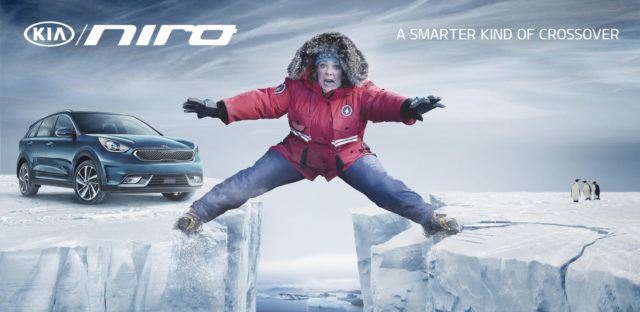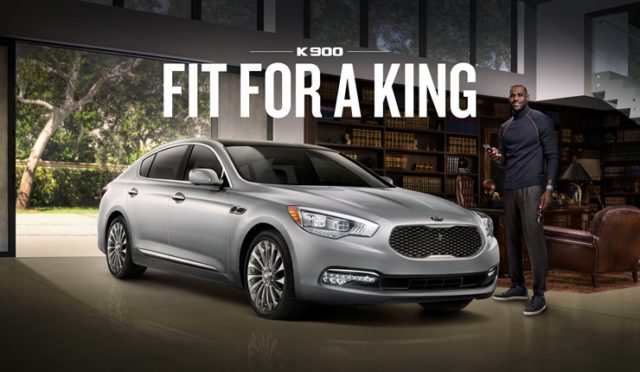Kia kicked off their marketing this year with a Super Bowl ad featuring Melissa McCarthy as a hapless eco-warrior promoting the Korean car company’s newest crossover model in the Niro Hybrid.
The spot was a strong follow-up to the commercials Kia aired the two previous years with Christopher Walken’s tour of his “Walken Closet” (2016) and Pierce Brosnan for the Kia Sorento (2015).
But their eighth consecutive appearance in the Big Game this year also marked a new method of messaging and utilization of marketing technology in debuting the brand’s Super Bowl commercial on the NiroBot for Facebook Messenger.
Although the ad had its day in the sun on the Falcons-Patriots telecast, leveraging the nascent conversational bot tool as part of a multi-faceted campaign was a step in the artificial intelligence path Kia wanted to take.
Kimberley Sweet Gardiner, director of marketing communications for Kia, and Nathalie Choy, senior web marketing manager for Kia, joined AListDaily to detail how they are using martech while also leveraging their role as an official automotive partner of the NBA.
What did you learn from being the first brand bot for Messenger to debut a Super Bowl ad?
Gardiner: This was in the works for quite some time. It wasn’t just for the Super Bowl. With Niro, we wanted to try something that we can connect with customers for a brand new vehicle challenging the likes of the Toyota Prius. We’re not the first [hybrid in the field]. We knew we had an uphill battle in having people consider and learn about our new car. We realized they would have a lot of questions in how is Niro different than any other hybrid out there. We needed a nice Q&A tool anyway, so we activated around a chatbot as a perfect and unique way to have consumers familiarized on Facebook Messenger about guided vehicle discovery, expansive technical knowledge, step-by-step tutorials and test drive scheduling. We knew we could extend it to other models. It was a perfect opportunity to get customers going on that journey.
Choy: It’s basically one-to-one marketing at scale. The fact that the Niro is a smarter kind of crossover car, we wanted to use a smarter kind of technology and a marketing channel to complement that, too. Using artificial intelligence and machine learning, the chat bot gain more awareness for Kia. It’s definitely an area of which we wanted to experiment in more to elevate the Kia brand.
What are some of the insights and analysis that you can share?
Choy: It’s been going really well! Since we launched in the middle of November, as of the beginning of April, we’ve had over 765,000 engagements between the consumer and the bot and 50,000 different users. Every day that number continues to grow. We are promoting it on our Kia site, email and all of our social platforms. Popular questions range from “what’s the miles-per-gallon?” or “what kind of technology, or color, do you come in?” or “what’s your engine like?” We can then augment a link to our website that offers consumers to get a test drive. The best part is that anytime they want to speak to an actual human, we can transfer the integrations seamlessly over to a person.
How do you plan on scaling?
Choy: There definitely is plans of that. Our executives headquartered in Korea are very interested in building out this bot. Not only does it serve marketing purposes, but for consumer affairs, the team that manages all of the customer support, they’re looking at leveraging those tools for recall information, and scheduling servicing and any type of warranty issues. We’re using this to see if it’s going to perform, and it definitely has exceeded our expectations. I think we’re going to explore other models and segments within our business.

Why is it critical for brands to move forward with multi-faceted marketing campaigns?
Gardiner: I tell my team that “I don’t want to see any gaps in the customer journey.” We want to helpful. So from whatever moment somebody gets interested in a product of the brand, the next series of moves they make should all be connected together. So, in other words, if someone sees our Melissa McCarty spot and wants to know more about it, we should be designing all of those “searchable” things up front. We should be putting ourselves on stage in the consumer’s shoes to say “okay, now what? . . . And now what?” That’s where a chat bot and other things we’re working on help put that into context. We don’t want to make a customer work too hard. We want to make it really seamless and easy. We want to be in technology not for the sake of it, but for it to help you. Taking all of that into context, we created a unified experience without making people work too hard. We have a whole initiative across our departments to figure that exact thing out, and technology will kind of be the piece that brings it all together.
What are the emerging marketing trends and technologies you’re zeroing in on in order to explore and innovate the Kia brand?
Choy: We have a bunch of marketing around augmented-and-virtual reality applications that allow consumers to virtually view the interiors of our cars to make it seem as if they were there. We’re exploring artificial intelligence a lot more. In addition to the chat bot, we’re also looking at voice-enabled consumer assistants such as Alexa and Google Home to be able to reach consumers at their moments. If you think about it, traditionally, people search for a website and once they land, they have to learn how to navigate in order to learn more. Voice-enablement takes that even a step further where you don’t even need the device anymore, you could just verbally ask whatever you want. We’re looking at each of the technology capabilities and identifying where that technology can help support in the customer-buying journey.
Is there a specific product or service that you’ve identified as your primary one for consumers?
Gardiner: For us, no, because we’re a challenger brand. We have pretty reasonably low awareness compared to some of the other brands that are out there. We’re not top of mind. We have to kind of cover a bunch of bases. We can’t be in just one space and say “that’s the one portal that we’re really going to focus on.” What we try to do is constantly look at where and what consumers are shopping for, so we’re working with a bunch of different partners to figure out what that one sweet spot for social media, search, website and mobile is. It’s different for other manufacturers. For us, we have a moment to capture your attention and keep you engaged because Kia may or may not be top of mind for you.
Will you be experimenting with influencer marketing to further gain a market share?
Gardiner: We have been doing influencer marketing for the last two years or so. We did one with IBM Watson during the Super Bowl last year. We have another one coming up in San Diego this summer around our Eco lineup, Niro, as well as a couple of other vehicles. We do them periodically. Corporate communications and our PR team jointly lead that with us. We have a super-engaged and passionate group of about 10-to-12 influencers that we work with on an ongoing basis. We need to grab people at different touch points to bring them into the conversation, so it’s not going to be just one vertical—it’s going to be multiple ones like music, art, fashion, design, lifestyle and travel across the board. The main thing that we want is for people to get to know Kia, and get really excited about working with us. From there, it’s an easy in because no matter where they’re coming from, the voice that they have is going to be genuine.
How do you find and identify influencers?
Gardiner: That’s a good question. I think for us, it’s those areas that we know are going to be important to our consumer base. So we did look at things like music, for example, as a big one. Design and travel is another one. We find that people may not have the most followers, but it’s not so much about quantity for us—it’s really more about the tone of the voice. Are they approachable? Are they easy to work with? Sometimes we find them organically, through events like Dad 2.0, Mom 2.0 and VidCon. Again, being a smaller brand, we’re much more about building relationships with our influencers. So being one-of-ten people we work with, rather than being one-of-one hundred, is a nice thing for us.
Choy: It’s about the message, too, and aligning what we are trying to achieve as a challenger brand.

Your partnership and marketing in the NBA has now reached 12 different teams. The Kia Optima is also the league’s “official vehicle.” How has Kia evolved and kept the marketing momentum running in the NBA going back to when it started in 2008?
Nathalie: Absolutely. We all know with live sports, especially with basketball, people tend to watch it more than once per week, and they tend to be engaged. The messaging we have is about the games.
Gardiner: We’ve been in the NBA for a number of years. A cool instance was when LeBron James reached out to us and said he’d be open to an opportunity to work with us because he loved the K900 sedan. We were lucky to have him seek us out, because we don’t have big budgets, massive resources and big teams to do that on a regular basis. We also had Kia patches on the All-Star game jerseys as part of a pilot program. It’s good for us to try those things, and be some of the “firsts.” We need those moments of exposure. When people ask “is [the NBA sponsorship] worth it?” My response is “yes, it’s working because we’re able to have so many different opportunities in games, broadcasts and even vehicle activations in arenas.” It gives us a lot of touchpoints because we’re a small brand that needs a lot of exposure over a period of time with people who are engaged. We only have a 3.7 percent market share.
Will you consider being one of the 30 NBA jersey sponsors for the upcoming season?
Gardiner: No. They want too much money. It’s way more than we can pocket. Some things just get way too big, and budgets get bigger, and we can’t necessarily afford it. But for us, again, the main thing is we need grow awareness about Kia. We can’t afford to spend dollars where people are not just going to be in the moment. But we’re working with the NBA for opportunities on other fronts. . . . You start off from small moments, and you build it from there. That’s really what we’re about.
Follow Manouk Akopyan on Twitter @Manouk_Akopyan
Air Fresheners that smell like your favorite @NBA teams! Free with test drive while supplies last at participating dealers. #ElevateTheGame pic.twitter.com/CTVuzIILbt
— Kia Motors America (@Kia) March 15, 2017

